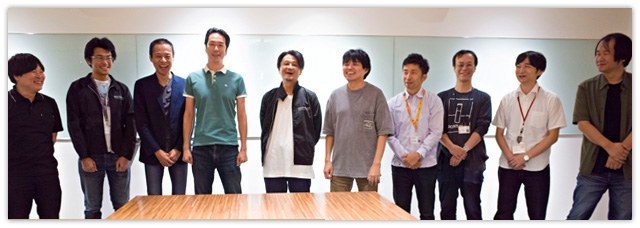
In the 10th Development Episode, we will share behind-the-scene stories on the development of ‘’ACE COMBAT7 SKIES UNKNOWN’’, the flight shooting game for Playstation®4 (*1) / Xbox One (*2) / STEAM® (*3), released in January 2019.
The ‘ACE COMBAT7 SKIES UNKNOWN’ (hereinafter referred to as ‘ACE COMBAT7’) development team:
| Masashi Koyanagi | Development Director |
|---|---|
| Hisaharu Tago | VR Director, DLC Director |
| Shinya Hirota | Multiplayer Mode Director |
| Masaki Iwabuchi | Engineering Director |
| Masato Aikawa | Lead Game Engineer |
| Haruyoshi Yamamoto | Lead VR Engineer |
| Masato Kanno | Art Director |
| Kosuke Itomi | Narrative Director |
| Shinya Sorimachi | Art Manager |
| Ryo Watanabe | Sound Director |
Development started from making cloud
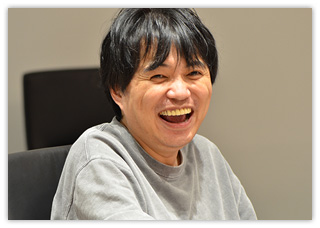
●Masashi Koyanagi
Development Producer
■Koyanagi: Though we all have been involved in this product, we would like to talk about how we started up this game first because this is the first one in 12 years in the series.
●Kanno: The Art team got started first. We drew tons of concept arts to decide what kind of plan we should make.
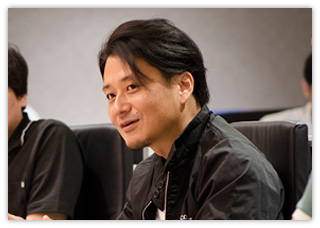
●Kosuke Itomi
Narrative Director
●Itomi: It was around 2012…so 7 years ago, I guess. I have a foggy memory (Laughter). On that time, shortly after ‘ACE COMBAT ASSAULT HORIZON’ (hereinafter referred to as ‘ACAH’), the plan for the next ACE COMBAT came up.
We had decided to use “cloud” as a concept early in development. We talked like “Let’s create three-dimensional field using cloud”, but it was just like a dream at that point because we didn’t have the technology of true SKY™ (*4) then.
First of all, we needed to test if using cloud really makes the game fun or not. So we created a field of cloud based on the ACAH environment, placing white, round objects in the air. And we found flying there was pretty fun.
I felt like we might be able to create some kind of play like a jungle gym which makes players think “I want to fly along cloud” or “I want to get into cloud”, not like before, just flying in the air. However, the development of ’7’ was suspended before it begins in earnest because it was decided to develop ‘ACE COMBAT INFINITY’ preferentially.
*4:true SKY™
The innovative real-time weather-generating system developed by Simul Software Ltd.
●Sorimachi: ‘ACE COMBAT INFINITY’ has been released in the spring in 2014 after its beta-test at the end of 2013. About the time its operation got on track, we resumed talks on the concept of ‘7’.
In the summer in 2014, we started to seek how to make three-dimensional cloud in a small group.
That was when we started again. We were doing a technical study in the company, but it was difficult because the goal we aimed for was so high.
In parallel with the study, we had asked Mr. Kanno to find middleware for Weather-Generating and we came to a conclusion that true SKY™ would be a good choice at the end of 2014. In 2015, we started to make a plan solid and decided to work with BANDAI NAMCO Studios Singapore (hereinafter referred to as ‘BNSS’) which was newly established.
●Koyanagi: In ‘INFINITY’ released after ‘ACAH’, the campaign (*5) had gotten back to the roots in a way. So, as the planning team, we tried to inherit that this time, too.
Also, we knew we needed to provide new fun, but we couldn’t afford to lose the most important part of ACE COMBAT – the excitement of becoming an ace pilot by defeating an opponent in a difficult situation at a player’s own discretion.
So, after ensuring those essential elements, we should start adding some new play in this project. That was what we thought and we stuck to the idea until the end. As a result, ‘7’ took over ‘INFINITY’ in many ways.
*5 Campaign
Playing a game alone to complete missions in a story.
●Kanno: I think the success of ‘INFINITY’ means a lot. Our customers have been connected through playing it. Additionally, we had many twists and turns as a result of taking a gamble in ACAH but because of that, we were able to find a chance to review mechanics of ACE COMBAT. I think everything led to ‘7’ in a good way.
●Sorimachi: A teaser trailer of ‘7’ using true SKY™ had been presented at “PlayStation Experience” (hereinafter referred to as “PSX”) at a quite early stage, right?
●Koyanagi: Uh-huh. Around that time, engineers told us repeatedly that game screens in the teaser were still just a small part of entire game. (Laughter)
●Itomi: Even the scenario was not ready at that time. The teaser was made to share the common goal, “Let’s make a game like this in the end.” In the complete version of product, engineers had fulfilled their work with the best quality. That was amazing.
●Sorimachi: When Mr. Itomi instructed an animator in BNSS, the studio I mentioned now, about a battle plane behavior, the animator was highly skilled and immediately understood everything. So, we could make a pretty nice teaser trailer using tools including true SKY™ and Unreal® Engine(*6), at least on the surface. (Laughter)
●Kanno: Since the quality of game screen in the teaser was excellent, artists and engineers who joined the project in the middle seemed to think that the game had been already completed. So, we told them that we had only made a concept at that point. Then, together with them, we developed ideas for missions and the scenario, made stories, and so on. After that, we asked Mr. Katabuchi, an animation director, to write a scenario in early 2016, right?
●Itomi: Yes. But before that, we had already started to make the teaser. So we constructed the scenario based on the teaser in some part.
●Sorimachi: We wanted to put three elements – space elevator, princess, and three-dimensional cloud.
●Itomi: In Rakugo, there’s an impromptu story-telling using three subjects called “Sandaibanashi”, you know. We were in the same situation then. We were thinking how we create a story with those three elements.
At first, I had been thinking that it would not be necessary to connect PSX2015 trailer scenes to ‘7’, but Mr. Kono, the brand director of ACE COMBAT series, said, “Yes, it’s necessary.” (Laughter)
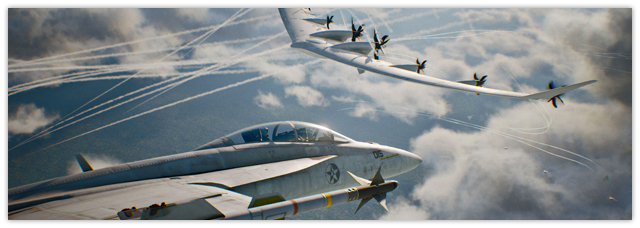
©ACE COMBAT™ 7:SKIES UNKNOWN & ©BANDAI NAMCO Entertainment Inc.
●Sorimachi: So just before ‘7’ was completed, those scenes were connected to it at last.
●Itomi: Yeah, I told him “How about just leaving those scenes as a product’s impression?” but he didn’t accept it. He has a good memory.
Cooperation with the overseas studio
■Koyanagi: Regarding the development system, we collaborated with BNSS, our overseas studio, for the first time.
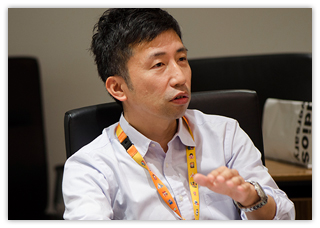
●Shinya Sorimachi
Art Manager
●Sorimachi: The Company had tried to place BNSS as an Asian hub. We were not sure if the collaboration would work or not, but it was an interesting attempt anyway. We came to know Singapore staff are highly capable of technology, at the same time, we recognized our workflow was too Japanese. We owe our successful teaser to their high skills.
We learned a lot from them and as this relationship is still ongoing, I want to continue learning from each other.
●Kanno: In BNSS, duties are divided up clearly to each person. I thought it’s so-called a western style. In a Japanese style, one engineer takes care of everything in a project. It’s totally different. For example, when Singapore staff make a tool for level designing, they divide their duties clearly. When they do something different, say, an engine modification, they divide their duties again. It’s just like that.
I think I had gotten used to Japanese engineers’ all-round skills. Through this project, I became aware that our previous working style was very Japanese.
●Sorimachi: Also about tools, now Hansoft or shotgun® are very popular but they were not at that time. It was good to know what kinds of software overseas people used. We also tried many ways of communication including a chat tool.
I installed a translation bot into the chat tool, but results were not so good. So eventually, I didn’t use it at all.
●Itomi: When we were creating the artistic part of ACAH, we had asked character design to an overseas artist or recorded performance-capture data in the United States. But we had never collaborated with an overseas studio as a whole production before. So, we experienced cultural gaps firsthand. For example, overseas people did not understand terms of storyboards we usually use. We struggled to explain what we wanted to tell. It was a good opportunity to learn how to communicate.
●Sorimachi: To communicate with an overseas outsourcing company, we used an interpreter.
But Singapore staff tried to communicate with us directly in English and I felt that was more efficient.
■Koyanagi: Mr. Iwabuchi, do you have any comments as an engineer?
●Iwabuchi: When I look back the production methods, we couldn’t switch over the Japanese-style to the overseas-style. That’s the point we need to reflect. BNSS created much of technical parts such as a multiplayer function and that was really helpful.
●Koyanagi: At first, also in various specifications, there were perception gaps between BNSS and us about which points were more important. I think we should have shared the concrete images of ‘ACE COMBAT7’ in details with all members early on.
●Hirota: In an early stage of the development of multiplayer function, we repeated trial and error because the development style was partially different from the Japanese one. But after Japanese network engineers joined the team around the middle of development, we became able to share what to create rapidly. Eventually, we could work together aiming for the common goal.
Borderless development with Unreal® Engine
■Koyanagi: This time, we adopted UE for the first time. What did you think about it?
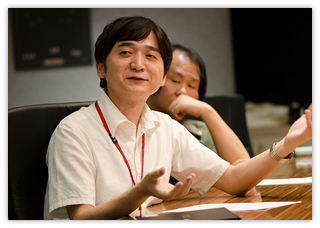
●Masato Aikawa
Lead Game Engineer
Once we started to develop using UE, we found we could run iterations quickly and make and confirm high-quality graphics right away. I think it was a good choice because using UE motivated us greatly. In my opinion, the most difficult part was the communication related to the game itself. I had a lot of troubles in explaining ACE COMBAT specifications in English to BNSS members who had never developed the series. Asking them to fix their work after my review was also difficult.
●Koyanagi: Also from the standpoint of planning, UE was very helpful. In a level setting for game missions, a level designer could visualize fun ideas into the substantial shape in short time. Thanks to that, a level designer could test ideas more widely than before. With UE, we can test whether and how an idea is interesting by repeating trial and error within a short span. That’s an advantage.
●Tago: UE helped us a lot in VR works, too. With UE, even if you are not an artist, you can visualize what you want or make similar data by yourself.
●Sorimachi: For the Visual team, it was good because true SKY™ can be used as a plug-in for UE.
Because of that, we could fix the final image early in the development and share it with team members as a goal. It was very useful.
●Kanno: Looking back, we didn’t need to wait for things like an implementation of features or others. Level designers took care of it in the end.
■Koyanagi: When I told a level designer “Now we can test many things!”, he was kind of upset, like “You know, it’s really hard for me!”, though. (Laughter)
By the way, Ryo-san (Mr. Watanabe), did you try something new technically as the Sound team?
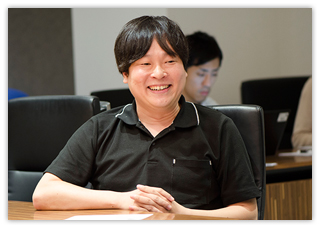
●Ryo Watanabe
Sound Director
Boom Library proposed us to use their technology because they have recognized ACE COMBAT as the best in battle plane games. Then we actually started to create sound preset together. In the past series, we went to the site a battle plane was actually flying to record its sound. But of course it was impossible to ask them like “OK, would you land next? Because we want that sound”, you know? (Laughter) But now we can express a sound as we wish by controlling a throttle condition on “TURBINE”.
Secondly, we’ve introduced the sound middleware “Wwise”. When we, sound designers needed to add some effects to sounds before, we had to ask an engineer each time, but this software enabled us to complete those works within the Sound team. I willingly tried many things because Wwise is so useful. As a result, I had too much work to do! (Laughter)
Also, we started to create “interactive music” using Wwise with consulting Mr. Itomi.
●Itomi: I feel guilty because it was a really tough work. (Laughter) But I think it was truly effective. I asked Mr. Watanabe and Mr. Okubo, who was responsible for making music, to try to overlay a chorus in real-time to the BGM of the sequence that Mihaly shows up in for the first time. And that sound fitted perfectly, so we decided to use it for a whole game. It was a massive amount of work, indeed.
●Watanabe: You handle music, too. So after you edit a video in pre-visualization, you gave it to us and told us “Please cut it here” from a very musical point of view. But we were at a loss like “How can we do…?”
●Itomi: I originally started it when I was making the trailer for ‘ACE COMBAT 6’. To make music, a composer Mr. Kobayashi and I needed to pass data each other often. So I asked him to pass me a stem, which is track-data of each part, and told him to make an adjustment after I edit and return it. With this method, we can completely synchronize a video and a music. I got a taste of this. (Laughter) And I had been longing for using this method somehow in making a game, too.
●Watanabe: Usually in the game music industry, people don’t like to be asked to give a stem. (Laughter) Nevertheless, Mr. Kobayashi passed it you. That means he trusts you.
●Itomi: It is like destroying the best quality music someone carefully created…
●Kanno: In other words, it’s just like saying to the Art team “Give us all Photoshop layers, we, the Sound team, will fix them all.” It’s kind of annoying, isn’t it? (Laughter)
●Watanabe: But when I saw the pre-visualization, I was astonished and got goosebumps like “Oh, cut the music HERE??” That was a very fresh idea a sound creator never thinks of. I think I could learn the possibility of the music conversely.
●Itomi: And your work increased more and more.
●Watanabe: Right. (Laughter) And I remembered one thing. We have a mechanism to make a sound of fly-pass, a sound when combat planes pass each other. After we took it over from Mr. Nakanishi, we have been using it in the series. When we make a fly-pass sound, we select an appropriate sound from a table considering elements such as a direction of overhead approach for landing, an entry angle, or a type of aircraft etc. Then the mechanism adjusts the selected sound to the one best suited for the situation. This patented mechanism has been used since ‘ACE COMBAT 3’ and I heard that the patent was expired the other day. That made me realize that the ACE COMBAT team kept trying to improve the products technologically since about 20 years ago.
Points to keep in mind when developing the campaign mode
●Koyanagi: We stuck to the main concept of this series – a player oneself judges, considers, and shoots. We paid much attention to details of mission specifications or level designing in campaign mode. For example, “We are sure that Erusea acts like this according to the change of the war situation because they have this kind of idea”, something like that. We also tried to make a situation that Trigger’s plane shows great actions while keeping consistency of military operations.
It was difficult because gimmicks or levels of each mission had to be fun or exhilarating at the same time. Moreover, we had to think about the scenario, too. To merge these three was indispensable to create amusing missions of ACE COMBAT.
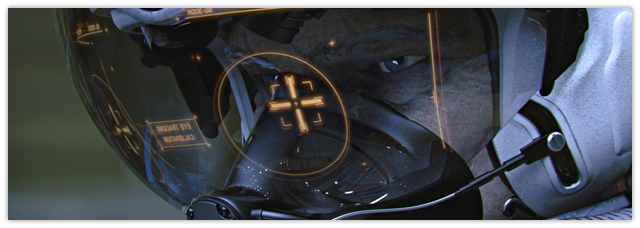
©ACE COMBAT™ 7:SKIES UNKNOWN & ©BANDAI NAMCO Entertainment Inc.
●Kanno: Sometimes it takes unexpected turns. (Laughter)
●Koyanagi: Yeah, it’s getting too much. Now no one trusts the briefing. (Laughter)
●Sorimachi: Right. It’s always like “Do the opposite”
●Koyanagi: One player was saying “I had a terrible time in a DLC mission even though I took an antiship missile!”
●Kanno: It’s very natural to take it because an opponent is a submarine.
●Itomi: Then, the combat was really in the air only.
●Sorimachi: It’s no wonder a player trusts a briefing at the first time.
●Itomi: Really? He took an antiship missile because he didn’t trust the briefing, didn’t he?
●Koyanagi: Yeah, I guess he must have thought “The briefing says we’ll capture enemy weapons, but I know I have to fight against a submarine anyway!”
●Iwabuchi: It’s like “The Boy who Cried Wolf”…
●Koyanagi: We had to ensure a player a sense of achievement. That was a difficult point. Although we had made Trigger to do various things to give a player a sense of achievement considering speculations of executives or a military of each country, it’s hard to say that was enough in both aspects of playing and situations. So, we revised all missions significantly after that. I know it was necessary in any case, but still, I think we should have made it with deeper consideration from the beginning.
●Sorimachi: This time, we aimed to show the sky using three-dimensional cloud. How did you balance anti-aircraft battles and anti-surface battles?
●Koyanagi: A player gets bored when battles in one situation such as anti-aircraft, anti-surface, or anti-ship are repeated too many times. So, I paid much attention not to repeat battles in a same situation in every phase, not a mission. And, when a player tries to destroy objects efficiently, he/she tends to shoot close ones only. But it makes a play boring, so, I set other plane’s annoying behaviors or interruptions in the sky to make a player want to shoot, especially in anti-surface battles. Though I wanted to make more battles full of wide, open atmosphere, I think it wasn’t perfect. So I did it in DLC. (Laughter)
●Kanno: We got feedback from players who played the released ‘ACE COMBAT 7’, then reflected the feedback to DLC. I think we learned this method through experiences in development of ‘ACE COMBAT INFINITY’.
■Koyanagi: Mr. Itomi, what do you think as a Narrative Director?
●Itomi: More than anything, I’m glad we could create this ‘7’ after 12 years. After we assured and improved past playing experiences, we put all elements required for ACE COMBAT, too. Even for a briefing alone, Mr. Suzuki in flapper3 Inc., who has been making a briefing since ‘INFINITY’, made a wonderful one this time. Adding to the essential, expected parts for the series, we also adopted some new methods for BGM and others. I think it has become even better in DLC.
●Kanno: A range of expression has been wider this time including intermissions. Like combining live-action and CG character or using illustration and motion graphics only, etc.
●Itomi: Many of them are starting from ‘INFINITY’. We mainly used motion graphics in ‘INFINITY’ because we were planning to develop the story only by briefings. In the ACE COMBAT series, we’ve changed a method of cutscenes every time. We used animation in ‘3’, combined still images and narration produced by Mr. Katabuchi in ‘4’, used full CG animation in ‘5’, and mixed live-action and CG in ‘zero’. We’ve used varieties of methods and ‘7’ is a compilation of all, I think.
●Sorimachi: In making of intermissions, we firstly thought about how we put Mr. Katabuchi’s scenario into moving images. Then we discussed with ILCA Inc. about how we make those images with limited budgets. After we went to shooting many locations including overseas with a large team, we could make the moving images combining live-action and CG in the end.
●Itomi: At meetings, we all searched a location suitable for each scene and if it’s possible to go there. Then, we asked Mr. Yoshizaki and Mr. Fukazawa, a shooting director, to go to the United States, Kita-kyusyu, Oshima, Chiba, Kichijoji, etc. for shooting with ILCA staffs.
Online multiplayer mode and VR mode development
■Koyanagi: Mr. Hirota, would you tell us about the development of online multiplayer mode?
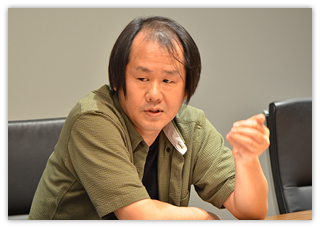
●Shinya Hirota
Multiplayer Mode Director
At the same time, we thought playable operations should be same in both the campaign mode and the multiplayer mode. This time, we added new operation called “Post Stall Maneuver (*7)”. If this maneuver cannot be used in the multiplayer mode, a player will think “Why?” right? So, we decided to add this also to the multiplayer mode though the communication load is heavy. And I felt the decision was right when I saw a video that a player was using this maneuver in a combat.
*7 Post Stall Maneuver
A flying operation after an aircraft was stalled. Implemented as a high-level operational technique for experienced players on some types of aircraft in ACE COMBAT 7.
●Aikawa: Oh, you prepared a script. (Laughter)
■Koyanagi: That’s why your story is well-organized. (Laughter)
Ok, let’s talk about the VR mode. I heard it has earned a great reputation.
●Yamamoto: At first, I heard that the PS4’s frame rate was 60 fps in the campaign mode, but later I knew that it was actually about 30 fps, so I thought it was difficult to make the VR mode. After that, we decided to develop the VR mode separately from the campaign mode and I think it was right.
●Tago: In making of the VR mode, it must have been so difficult to give realistic sounds according to the situation in the game. Ryo-san (Mr. Watanabe), please tell us about it.
●Watanabe: Well, I was going to use sounds same as the campaign mode first and I assumed a month or so was enough. However, once I heard the campaign mode sounds with the VR headset, I found it so cheap. Only then, I recognized it was a tough work. Since then, I needed to do so many things including making stereophonic sounds to give a sense of immersion. It was really tough because unlike the campaign mode, I had to prepare all sounds even for invisible parts in the game. I adjusted sounds again and again and eventually, the sounds for VR mode became totally different from ones for the campaign mode as if they are different games.
●Itomi: In the VR mode, multiple kinds of sounds such as ACE COMBAT BGM, cockpit sounds, radio communication sounds need to be played at the same time. We have obtained a certain level of knowledge for balancing them through the series, but I clearly realized it doesn’t work for the VR mode.
●Watanabe: Firstly, to give the VR sound presentation, I watched so many internet videos and DVDs to know what kinds of sounds do you hear at a cockpit for about half a year. Then I deeply understood that a pilot is struggling with incredible fear and loneliness relying just on radio communications when fighting against an enemy. But I also knew the kind of showy, dramatic taste of ACE COMBAT would be lost if I create very real sounds. So when I was creating VR sounds, I tried to find a middle ground between the campaign mode as a flight shooting game and the VR mode which offers a sense of realism.
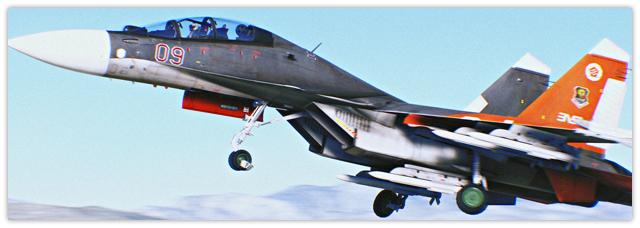
©ACE COMBAT™ 7:SKIES UNKNOWN & ©BANDAI NAMCO Entertainment Inc.
●Yamamoto: I was so impressed by the BGM in the hanger. At first, I felt it very natural. Then as I get excited gradually, the BGM also gets more and more exciting. At the moment the aircraft takes off, the music suddenly becomes quiet and only the engine sound is left as if it reflects my feelings. Ryo-san (Mr. Watanabe) made this sequence of sounds on his first attempt. That’s really something.
●Watanabe: For that scene, I laid over sound parts interactively. Before starting, some of us had considered music was not necessary for the hanger scene. But we found it was just a flight simulator when we played it without music. So, I put music made by Mr. Kobayashi and the development team, and I thought “This is ACE COMBAT”! I am sure not only me but also every project member felt the same way. I realized the power of music once again.
●Kanno: As you talked at CEDEC, the team made so much effort to put expected things as ACE COMBAT into the VR mode. “It’s not ACE COMBAT without music” is one of them.
●Watanabe: Yeah, only after trying the version without music, we realized it’s indispensable.
●Kanno: Also, thanks to the timing of the Doppler effect in explosions, the sound made us easily understand the situation.
●Watanabe: Right. I used the same method in both the campaign mode and the VR mode. Mr. Kanno asked me to create sound that makes players feel a vast space, and it was very difficult (Laughter). So a programmer and I tested many patterns – a delay or the Doppler effect which gives a sense of distance, or physically conceivable sounds, and so on.
Interestingly, it didn’t sound like ACE COMBAT at all when we input the real data. When I played it, I found the exciting, dramatic feeling that a flight shooting game supposed to have was lost. So I was able to find a right point as a game eventually.
●Kanno: Through the development of the VR mode this time, people who had not been interested in ACE COMBAT or real pilots became interested in or even advertised ACE COMBAT. Many companies paid much attention, too. That made me think that VR is a platform that we can develop in various way once again.
●Sorimachi: We wanted to make all missions in the VR mode, didn’t we?
●Watanabe: Yeah… Cutscenes in the VR mode had also been completed to the stage of the Audio Post Production. But Mr. Kono said “It cannot be released if you cannot actually play it”, and it was canceled… (Laughter)
●Itomi: We discussed it until the very last minute, but we didn’t eventually.
Realistic feeling generated by sound
■Koyanagi: Did you do something special for the sound of the Air Show?
●Watanabe: Yes. I created the sound especially for the Air Show because Mr. Nakanishi and Mr. Kono are so acquainted with it. (Laughter) They told me “The same sound as the VR mode is just fine” at first. But after that, I was told to make it over again and again. In an air show, the sound is ear deafening. They said, “You don’t know from which direction an aircraft is coming until the aircraft comes very close, right? You have to express that feeling of sound localization perfectly.” I remember I had to spend about three months only for that. (Laughter) At last, I’ve achieved a terrific impact and loudness using a full range of volume until just before a digital clip happens. I think it’s not easy to find a game like this.
●Kanno: You also did a great job using an echo-effect.
●Watanabe: Uh-huh. I heard that music playing while people are watching an air show is supposed to come from speakers on deck. And, when it comes to an air show, it’s rock ‘n’ roll, isn’t it? So I decided to use my favorite ‘ACE COMBAT 2’ and gave it effects as if the sound was coming from speakers on deck.
●Kanno: There’s a game “Family Ski”, you know? (*8) I love that game so much. Because usually, efforts to express the theme of Ski can be found in things like a shape of ski edge, how to move poles, or a texture of snow, right? But for me, a trigger was music. At the beginning of the game, the moment I heard a music from speakers echoed in the ski slope, I thought, “This is it”. I felt like I was right there. The music of the Air Show in the VR mode reminded me that experience. I believe sound is a major part making up a world.
*8 Family Ski
The game released by BANDAI NAMCO Games Inc. (Current BANDAI NAMCO Entertainment Inc.) in 2008.
●Watanabe: That was the part Mr. Okubo was dedicated to in Family Ski. I was so impressed and did the same thing for ACE COMBAT this time.
Official website
https://ace7.acecombat.jp/
Distributer: BANDAI NAMCO Entertainment
ACE COMBAT™ 7:SKIES UNKNOWN & ©BANDAI NAMCO Entertainment Inc.
*All company names and product names are trademarks or registered trademarks of their respective companies.
(*1)”PlayStation” is the trademark or a registered trademark of Sony Interactive Entertainment Inc.
(*2)”Xbox One” is the trademark or a registered trademark of Microsoft Corporation in the United States of America and/or related companies.
(*3)”©2019 Valve Corporation. Steam” and the logo of “Steam” are trademarks or registered trademarks of Valve Corporation in the United States of America and elsewhere
(*6)Unreal® is a trademark or registered trademark of Epic Games, Inc. in the United States of America and elsewhere. Unreal® Engine, Copyright 1998 – 2019, Epic Games, Inc. All rights reserved.
「ACE COMBAT™7:SKIES UNKNOWN」
ACE COMBAT™ 7:SKIES UNKNOWN & ©BANDAI NAMCO Entertainment Inc.
© DigitalGlobe, Inc. All Rights Reserved.
All trademarks and copyrights associated with the manufacturers, aircraft, models, trade names, brands and visual images depicted in this game are the property of their respective owners, and used with such permissions.




